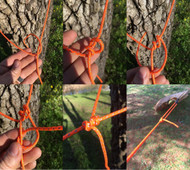Camping knots you should know
Posted by on 4th Apr 2019
Camping knots you should know
Camping knots fill specific purposes, and there are so many available that it is hard to remember how to tie them all, especially in the dark with fingers numb from cold.
Our recommendation is to select the best knots for the most common tasks you face, and stick with those few. The knot you remember is better than the one you forget.
The most common tasks you’ll find for a knot when using your Seek Outside gear are:
- Connecting a line to a tent pole
- Tying a line to a tree
- Connecting line to a guyout loop
- Tying off a line to a stake
Connecting a line to a tent pole
The tent pole is much stronger than the canopy, and is the go-to choice for rigging a clothesline to hang boots, pants, or heavy gear from. This is also how to tension the top of a nest.
There is more than one way to attach a line to your pole, but by far our favorite is using a Prusik Loop on the pole, and then connecting a dryline or nest tension line to the Prusik with a mini carabiner or a slip knot.
Prusik on the Pole
This knot is adjustable up and down the pole yet holds securely once tension is applied. It is easy to both tie and untie, and is simple to remember.
To make the Prusik Knot, simply start with a length of cordage around 30” long. Form a loop using an Overhand Knot or a Waterman Knot (both work, the Overhand is faster, Waterman is stronger).
You now have a loop roughly 12”-14” in diameter. Drape the loop over the pole and bring one end through the other end 3 times. Tighten the loop and dress the knot so everything stays smooth.
A mini carabiner or a slip knot such as the Halter Hitch (see below) can be used to attach a line to a dryline or nest tension line to the Prusik Loop for quick detach, which also allows the prusik to stay on the pole when you strike camp.
Tying a line to a tree
When using a flat tarp as a primary shelter it is very easy to tie off your guyline to a tree to start the pitch. This works well both in the diamond fly and A-frame pitches.
Another use for tying off to a branch or tree is anchoring a guyline to make more room inside a shelter, or to help stabilize the pitch on uneven ground or during high winds.
Halter Hitch
This knot is so familiar to me that I can tie it with my eyes closed. I grew up on a farm and showed cattle in 4-H, and this is THE knot to tie a haltered animal to anything solid.
What makes this knot useful is that it is very strong, and almost never binds enough that you can’t get it loose. In cases when it may bind (such as a 1200 lb steer yanking on it) you can take an extra turn around the post before tying off, and it’ll come loose easily.
This knot is fast to tie, easy to remember, holds strongly, and is easy to untie. It doesn’t get much better in my opinion.
Remember to run the tag end back through the loop and there isn’t any chance of this knot coming loose until you want it to.
Connecting line to a guyout loop
Two scenarios are common with guylines - tying a guyline on only if needed, and leaving guylines attached semi-permanently.
If you’re tying guylines on only when needed then I prefer a halter hitch as it is fast, easy, and quickly removed.
If the guylines will be left on longer term, or if you want tensioning ability in the guyline, then a Taut Line Hitch is the way to go.
Taut Line Hitch
The Taut Line Hitch forms a slip loop that moves easily when not under tension, but holds fast when tension is applied.
Attach the guyline to the shelter by first running the line through the guyout loop, and then tying the Taut Line Hitch.
This arrangement allows you to tie the far end of the line to a tree, branch, or stake, and then add tension using the Taut Line Hitch on the shelter side.
This guyline method is secure and adaptable, and is why my DST sports Taut Line Hitch guylines.
Tying off a line to a stake
Anchoring a line to a stake can be a pain. It seems either the knots slip, or they bind and can’t be loosened when you’re striking camp.
I have settled on a series of Half Hitches to anchor line to a stake. I can secure the line with three or four half hitches and be confident in holding power, yet still extract my guyline from the stake when I want.
Half Hitch
The Half Hitch is formed by making a loop, then flipping that loop over the head of the stake and tightening the tag end.
One half hitch can slip, but another half hitch can be thrown over the first, then another. I can throw three half hitches on a stake in just a couple seconds and be confident the guyline will hold fast even on the windiest nights.
This hitch can be thrown even under a bit of tension, so you can stretch the guyline a bit before tying off.
The Half Hitch is all around a useful knot to know.
…